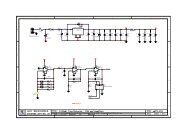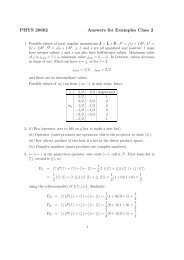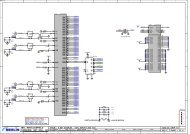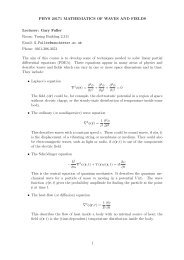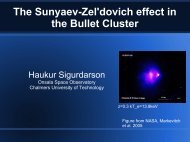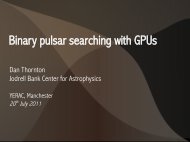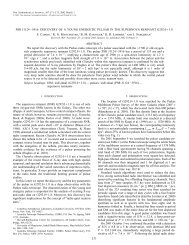Wide-field VLBI Techniques: A Beginner's Guide
Wide-field VLBI Techniques: A Beginner's Guide
Wide-field VLBI Techniques: A Beginner's Guide
You also want an ePaper? Increase the reach of your titles
YUMPU automatically turns print PDFs into web optimized ePapers that Google loves.
<strong>Wide</strong>-<strong>field</strong> <strong>VLBI</strong> UV Shifting Using <strong>Wide</strong>-<strong>field</strong> <strong>VLBI</strong> Future Work References<br />
<strong>Wide</strong>-<strong>field</strong> <strong>VLBI</strong> <strong>Techniques</strong>: A Beginner’s <strong>Guide</strong><br />
John Morgan, ICRAR, Curtin University, Perth<br />
10th EVN Symposium<br />
Manchester<br />
Tuesday 21st September 2010<br />
<strong>Wide</strong>-<strong>field</strong> <strong>VLBI</strong> <strong>Techniques</strong>: A Beginner’s <strong>Guide</strong><br />
1 / 28
<strong>Wide</strong>-<strong>field</strong> <strong>VLBI</strong> UV Shifting Using <strong>Wide</strong>-<strong>field</strong> <strong>VLBI</strong> Future Work References<br />
1 <strong>Wide</strong>-<strong>field</strong> <strong>VLBI</strong><br />
<strong>VLBI</strong> Sensitivity<br />
Correlation<br />
Imaging<br />
2 UV Shifting<br />
Transforming correlated data<br />
Using the baseline vectors<br />
Using correlator delay model<br />
3 Using <strong>Wide</strong>-<strong>field</strong> <strong>VLBI</strong><br />
4 Future Work<br />
Future Work<br />
Conclusions<br />
Overview<br />
<strong>Wide</strong>-<strong>field</strong> <strong>VLBI</strong> <strong>Techniques</strong>: A Beginner’s <strong>Guide</strong><br />
2 / 28
<strong>Wide</strong>-<strong>field</strong> <strong>VLBI</strong> UV Shifting Using <strong>Wide</strong>-<strong>field</strong> <strong>VLBI</strong> Future Work References<br />
Acknowledgements<br />
I would like to acknowledge useful discussions and material help from<br />
many people.<br />
⇒ Adam Deller<br />
⇒ Walter Brisken<br />
Also many others including (in no particular order) Franco Mantovani, Steven<br />
Tingay, Walter Alef, Helge Rottman, Enno Middelberg, Richard Porcas<br />
<strong>Wide</strong>-<strong>field</strong> <strong>VLBI</strong> <strong>Techniques</strong>: A Beginner’s <strong>Guide</strong><br />
3 / 28
<strong>Wide</strong>-<strong>field</strong> <strong>VLBI</strong> UV Shifting Using <strong>Wide</strong>-<strong>field</strong> <strong>VLBI</strong> Future Work References<br />
A simple ‘figure of merit’<br />
For an interferometer with dishes of diameter d separated by D the<br />
primary beam Θ and resolution θ are given by<br />
θ ≈ λ λ<br />
,Θ ≈ 1.22·<br />
D d<br />
(1)<br />
So the number of resolution units across the primary beam is<br />
Θ<br />
θ = D ( ) D 2<br />
d ⇒ n pixel ∼ (2)<br />
d<br />
n.b. for imaging purposes the true number of pixels will be ∼ 10× bigger<br />
<strong>Wide</strong>-<strong>field</strong> <strong>VLBI</strong> <strong>Techniques</strong>: A Beginner’s <strong>Guide</strong><br />
4 / 28
<strong>Wide</strong>-<strong>field</strong> <strong>VLBI</strong> UV Shifting Using <strong>Wide</strong>-<strong>field</strong> <strong>VLBI</strong> Future Work References<br />
Image size of different arrays<br />
Array d D D/d<br />
m km<br />
VLA 25 36 1440<br />
MERLIN 32 217 8680<br />
EVN 100 10180 101800<br />
VLBA 25 8611 344440<br />
n.b. All arrays in longest-baseline/smallest-antenna configuration<br />
<strong>Wide</strong>-<strong>field</strong> <strong>VLBI</strong> <strong>Techniques</strong>: A Beginner’s <strong>Guide</strong><br />
5 / 28
<strong>Wide</strong>-<strong>field</strong> <strong>VLBI</strong> UV Shifting Using <strong>Wide</strong>-<strong>field</strong> <strong>VLBI</strong> Future Work References<br />
Three Caveats<br />
<strong>Wide</strong><strong>field</strong> <strong>VLBI</strong> techniques are only useful if:<br />
⇒ There are enough bright sources on the sky that more than one will fall<br />
within the primary beam<br />
⇒ It is possible to correlate with sufficient resolution to cover the large area<br />
⇒ There are appropriate techniques to handle the resulting large datasets<br />
<strong>Wide</strong>-<strong>field</strong> <strong>VLBI</strong> <strong>Techniques</strong>: A Beginner’s <strong>Guide</strong><br />
6 / 28
<strong>Wide</strong>-<strong>field</strong> <strong>VLBI</strong> UV Shifting Using <strong>Wide</strong>-<strong>field</strong> <strong>VLBI</strong> Future Work References<br />
Caveat 1: Density of Detectable Sources<br />
⇒ This depends on the sensitivity of <strong>VLBI</strong><br />
⇒ However even a decade ago it was possible to detect multiple sources<br />
⇒ Sensitivity (and therefore density of detectable sources on the sky) is<br />
increasing all the time<br />
<strong>Wide</strong>-<strong>field</strong> <strong>VLBI</strong> <strong>Techniques</strong>: A Beginner’s <strong>Guide</strong><br />
7 / 28
<strong>Wide</strong>-<strong>field</strong> <strong>VLBI</strong> UV Shifting Using <strong>Wide</strong>-<strong>field</strong> <strong>VLBI</strong> Future Work References<br />
Caveat 2: Offset source visibility phases in<br />
time/frequency<br />
Phase/Degrees<br />
200<br />
150<br />
100<br />
50<br />
0<br />
-50<br />
-100<br />
⇒ The size of the image that can be<br />
made is determined by how much<br />
averaging is done of the data<br />
→ The number of channels<br />
→ The integration time<br />
-150<br />
-200<br />
Time or Frequency<br />
0 offset<br />
offset<br />
<strong>Wide</strong>-<strong>field</strong> <strong>VLBI</strong> <strong>Techniques</strong>: A Beginner’s <strong>Guide</strong><br />
8 / 28
<strong>Wide</strong>-<strong>field</strong> <strong>VLBI</strong> UV Shifting Using <strong>Wide</strong>-<strong>field</strong> <strong>VLBI</strong> Future Work References<br />
How to generate the <strong>Wide</strong>-<strong>field</strong> Dataset<br />
⇒ Generating high-resolution datasets was a problem for hardware correlators<br />
→ It was this which limited the <strong>field</strong> of view for <strong>Wide</strong>-<strong>field</strong> <strong>VLBI</strong> until recently<br />
⇒ With software correlators such as DiFX (Deller et al. 2007) the time penalty<br />
is acceptable.<br />
→ Greater CPU resources required for greater number of channels<br />
⇒ The main problem is the output data volume<br />
→ ∼ TB for a typical VLBA observation<br />
<strong>Wide</strong>-<strong>field</strong> <strong>VLBI</strong> <strong>Techniques</strong>: A Beginner’s <strong>Guide</strong><br />
9 / 28
<strong>Wide</strong>-<strong>field</strong> <strong>VLBI</strong> UV Shifting Using <strong>Wide</strong>-<strong>field</strong> <strong>VLBI</strong> Future Work References<br />
Caveat 3: <strong>Wide</strong>-<strong>field</strong> Imaging<br />
Direct wide-<strong>field</strong> imaging<br />
Very quickly becomes slow<br />
⇒ Will quickly fill computer memory<br />
⇒ Non-coplanar effects to handle<br />
⇒ parallel algorithms are in development<br />
Correlating with different phase centres<br />
⇒ Ties up correlator (and media)<br />
Correlating, transforming and averaging<br />
⇒ Correlate to create one large dataset<br />
⇒ Use this to generate several smaller datasets<br />
<strong>Wide</strong>-<strong>field</strong> <strong>VLBI</strong> <strong>Techniques</strong>: A Beginner’s <strong>Guide</strong><br />
10 / 28
<strong>Wide</strong>-<strong>field</strong> <strong>VLBI</strong> UV Shifting Using <strong>Wide</strong>-<strong>field</strong> <strong>VLBI</strong> Future Work References<br />
Transforming correlated data<br />
Phase/Degrees<br />
200<br />
150<br />
100<br />
50<br />
0<br />
-50<br />
-100<br />
⇒ Transform one dataset into the<br />
other.<br />
⇒ Then the data can be averaged<br />
⇒ Repeat for every region of interest<br />
-150<br />
-200<br />
Time or Frequency<br />
0 offset<br />
offset<br />
<strong>Wide</strong>-<strong>field</strong> <strong>VLBI</strong> <strong>Techniques</strong>: A Beginner’s <strong>Guide</strong><br />
11 / 28
<strong>Wide</strong>-<strong>field</strong> <strong>VLBI</strong> UV Shifting Using <strong>Wide</strong>-<strong>field</strong> <strong>VLBI</strong> Future Work References<br />
Geometry<br />
The correlator has already shifted the datastreams so that the two antennas are<br />
on a baseline perpendicular to the original phase centre:<br />
Consider a phase centre offset from this position<br />
<strong>Wide</strong>-<strong>field</strong> <strong>VLBI</strong> <strong>Techniques</strong>: A Beginner’s <strong>Guide</strong><br />
12 / 28
<strong>Wide</strong>-<strong>field</strong> <strong>VLBI</strong> UV Shifting Using <strong>Wide</strong>-<strong>field</strong> <strong>VLBI</strong> Future Work References<br />
Correlating, Transforming and Averaging<br />
⇒ We start with the correlated data<br />
⇒ Calculate a new delay for<br />
→ each baseline<br />
→ each time integration<br />
⇒ Apply a phase shift to each datum<br />
→ time dependent<br />
→ frequency dependent<br />
<strong>Wide</strong>-<strong>field</strong> <strong>VLBI</strong> <strong>Techniques</strong>: A Beginner’s <strong>Guide</strong><br />
13 / 28
<strong>Wide</strong>-<strong>field</strong> <strong>VLBI</strong> UV Shifting Using <strong>Wide</strong>-<strong>field</strong> <strong>VLBI</strong> Future Work References<br />
How to calculate the delay?<br />
This is what the baseline vectors are for!<br />
They can be used to calculate the delay at any point in the image:<br />
∆φ = 2π λ<br />
(lu+mv) (3)<br />
The correlator delay model takes more into account than simple<br />
geometry (Sovers et al. 1998)<br />
DiFX actually calculates the baselines using the full accuracy of the<br />
correlator delay model:<br />
( ∂τ<br />
(u, v, w) = c<br />
∂l , ∂τ )<br />
∂m ,τ , (4)<br />
These differ by up to 1 part in 10 000 from purely geometrical vectors.<br />
(Walter Brisken Priv. Comm.)<br />
<strong>Wide</strong>-<strong>field</strong> <strong>VLBI</strong> <strong>Techniques</strong>: A Beginner’s <strong>Guide</strong><br />
14 / 28
<strong>Wide</strong>-<strong>field</strong> <strong>VLBI</strong> UV Shifting Using <strong>Wide</strong>-<strong>field</strong> <strong>VLBI</strong> Future Work References<br />
How to calculate the delay?<br />
There is still a problem<br />
⇒ There is only one value of u and v for each visibility<br />
We are treating the delay across the wide <strong>field</strong> as a linear function<br />
<strong>Wide</strong>-<strong>field</strong> <strong>VLBI</strong> <strong>Techniques</strong>: A Beginner’s <strong>Guide</strong><br />
15 / 28
<strong>Wide</strong>-<strong>field</strong> <strong>VLBI</strong> UV Shifting Using <strong>Wide</strong>-<strong>field</strong> <strong>VLBI</strong> Future Work References<br />
CALC 9 generated delays across the wide <strong>field</strong><br />
1000<br />
100<br />
10<br />
delay<br />
1<br />
0.1<br />
0.01<br />
MaMc<br />
MaWz<br />
McWz<br />
0.001<br />
0.01 0.1 1 10 100<br />
offset/arcminutes<br />
The delay function varies smoothly throughout the sky<br />
No reason to think this isn’t typical<br />
<strong>Wide</strong>-<strong>field</strong> <strong>VLBI</strong> <strong>Techniques</strong>: A Beginner’s <strong>Guide</strong><br />
16 / 28
<strong>Wide</strong>-<strong>field</strong> <strong>VLBI</strong> UV Shifting Using <strong>Wide</strong>-<strong>field</strong> <strong>VLBI</strong> Future Work References<br />
Fractional error of a linear fit<br />
0.1<br />
0.01<br />
0.001<br />
0.0001<br />
1e-05<br />
1e-06<br />
0.01 0.1 1 10 100<br />
offset/arcminutes<br />
Fit forced through 0 at the origin and 0.3 arcminute point<br />
Similar to the derivation done by DiFX<br />
<strong>Wide</strong>-<strong>field</strong> <strong>VLBI</strong> <strong>Techniques</strong>: A Beginner’s <strong>Guide</strong><br />
17 / 28
<strong>Wide</strong>-<strong>field</strong> <strong>VLBI</strong> UV Shifting Using <strong>Wide</strong>-<strong>field</strong> <strong>VLBI</strong> Future Work References<br />
Error of using a linear fit<br />
⇒ This is the reason for the UV shifting errors noted by others<br />
(Lenc et al. 2008; Middelberg et al. 2008)<br />
⇒ it cannot be calibrated out<br />
⇒ It is made whenever using UV data to look at flux away from the phase<br />
centre<br />
(though the error may be negligable for shorter shifts)<br />
<strong>Wide</strong>-<strong>field</strong> <strong>VLBI</strong> <strong>Techniques</strong>: A Beginner’s <strong>Guide</strong><br />
18 / 28
<strong>Wide</strong>-<strong>field</strong> <strong>VLBI</strong> UV Shifting Using <strong>Wide</strong>-<strong>field</strong> <strong>VLBI</strong> Future Work References<br />
Accurate UV shifting<br />
By generating a second correlator model for the desired phase centre it<br />
should be possible to UV shift accurately.<br />
No need to recorrelate:<br />
⇒ We start with the correlated data<br />
⇒ Replace the phase centre coordinates<br />
⇒ Replace the baseline vectors (UVW)<br />
⇒ Apply the phase shift to each visibility<br />
→ difference in delay between the two models (multiplied by the frequency)<br />
<strong>Wide</strong>-<strong>field</strong> <strong>VLBI</strong> <strong>Techniques</strong>: A Beginner’s <strong>Guide</strong><br />
19 / 28
<strong>Wide</strong>-<strong>field</strong> <strong>VLBI</strong> UV Shifting Using <strong>Wide</strong>-<strong>field</strong> <strong>VLBI</strong> Future Work References<br />
Take into account delay rate<br />
There is still an error of one part in<br />
10 6<br />
⇒ The delay is changing with time<br />
⇒ Need to take into account the<br />
change in delay over the shift<br />
Another error which is always<br />
present but only measurable for the<br />
most extreme wide-<strong>field</strong> <strong>VLBI</strong><br />
<strong>Wide</strong>-<strong>field</strong> <strong>VLBI</strong> <strong>Techniques</strong>: A Beginner’s <strong>Guide</strong><br />
20 / 28
<strong>Wide</strong>-<strong>field</strong> <strong>VLBI</strong> UV Shifting Using <strong>Wide</strong>-<strong>field</strong> <strong>VLBI</strong> Future Work References<br />
Error after a phase shift of 1000000 turns<br />
180<br />
CALC dataset<br />
Reference dataset<br />
90<br />
Phase/Degrees<br />
0<br />
-90<br />
Phase/Degrees<br />
-180<br />
5<br />
4<br />
3<br />
2<br />
1<br />
0<br />
-1<br />
-2<br />
Residuals and Chi 2 linear fit: y = 0.313256x + -2632.42 (r 2 =0.458702)<br />
8408 8409 8410 8411<br />
Frequency/MHz<br />
(Morgan et al. 2010)<br />
<strong>Wide</strong>-<strong>field</strong> <strong>VLBI</strong> <strong>Techniques</strong>: A Beginner’s <strong>Guide</strong><br />
21 / 28
<strong>Wide</strong>-<strong>field</strong> <strong>VLBI</strong> UV Shifting Using <strong>Wide</strong>-<strong>field</strong> <strong>VLBI</strong> Future Work References<br />
Error after a phase shift of 1000000 turns<br />
180<br />
CALC dataset<br />
Reference dataset<br />
90<br />
Phase/Degrees<br />
0<br />
-90<br />
Phase/Degrees<br />
-180<br />
Residuals and Chi 2 linear fit: y = 0.0505706x + 0.588864 (r 2 =0.408585)<br />
8<br />
6<br />
4<br />
2<br />
0<br />
-2<br />
-4<br />
-6<br />
0 10 20 30 40 50<br />
Time/s<br />
(Morgan et al. 2010)<br />
<strong>Wide</strong>-<strong>field</strong> <strong>VLBI</strong> <strong>Techniques</strong>: A Beginner’s <strong>Guide</strong><br />
22 / 28
<strong>Wide</strong>-<strong>field</strong> <strong>VLBI</strong> UV Shifting Using <strong>Wide</strong>-<strong>field</strong> <strong>VLBI</strong> Future Work References<br />
Implementations<br />
This is implemented with full accuracy in:<br />
⇒ difx2fits (not in the standard release)<br />
The latest release of DiFX (2.0) also implements the shifting algorithm<br />
with full accuracy<br />
⇒ The extremely high resolution dataset never leaves the computer’s memory<br />
⇒ The PI receives one standard visibility datset for each requested phase<br />
centre<br />
⇒ The computational efficiency is breathtaking!<br />
(Deller et al. 2010)<br />
<strong>Wide</strong>-<strong>field</strong> <strong>VLBI</strong> <strong>Techniques</strong>: A Beginner’s <strong>Guide</strong><br />
23 / 28
<strong>Wide</strong>-<strong>field</strong> <strong>VLBI</strong> UV Shifting Using <strong>Wide</strong>-<strong>field</strong> <strong>VLBI</strong> Future Work References<br />
Amplitude Correction and Calibration<br />
Correction for smearing:<br />
⇒ Amplitude correction can be calculated fairly accurately from the shift delay<br />
⇒ Larger than simple smearing for DiFX due to triangular weight function<br />
(Morgan et al. 2010)<br />
Primary Beam:<br />
⇒ Assume that within a single image the correction is the same<br />
⇒ Adjust the visibilities for the primary beam response of the baseline<br />
→ time & frequency dependent<br />
(See my poster for more details)<br />
<strong>Wide</strong>-<strong>field</strong> <strong>VLBI</strong> <strong>Techniques</strong>: A Beginner’s <strong>Guide</strong><br />
24 / 28
<strong>Wide</strong>-<strong>field</strong> <strong>VLBI</strong> UV Shifting Using <strong>Wide</strong>-<strong>field</strong> <strong>VLBI</strong> Future Work References<br />
Amplitude Correction and Calibration<br />
Correction for smearing:<br />
⇒ Amplitude correction can be calculated fairly accurately from the shift delay<br />
⇒ Larger than simple smearing for DiFX due to triangular weight function<br />
(Morgan et al. 2010)<br />
Primary Beam:<br />
⇒ Assume that within a single image the correction is the same<br />
⇒ Adjust the visibilities for the primary beam response of the baseline<br />
→ time & frequency dependent<br />
(See my poster for more details)<br />
<strong>Wide</strong>-<strong>field</strong> <strong>VLBI</strong> <strong>Techniques</strong>: A Beginner’s <strong>Guide</strong><br />
24 / 28
<strong>Wide</strong>-<strong>field</strong> <strong>VLBI</strong> UV Shifting Using <strong>Wide</strong>-<strong>field</strong> <strong>VLBI</strong> Future Work References<br />
Future Work<br />
We can generate a model for any point on the primary beam<br />
What would be better would be to characterise the delay across the entire<br />
primary beam<br />
⇒ not just u, v and w but also higher terms<br />
This would allow the calculation of the delay at any point with full<br />
accuracy.<br />
<strong>Wide</strong>-<strong>field</strong> <strong>VLBI</strong> <strong>Techniques</strong>: A Beginner’s <strong>Guide</strong><br />
25 / 28
<strong>Wide</strong>-<strong>field</strong> <strong>VLBI</strong> UV Shifting Using <strong>Wide</strong>-<strong>field</strong> <strong>VLBI</strong> Future Work References<br />
Radio Astronomers do it in four dimensions<br />
⇒ Accurate UV shifting at any point during correlation, calibration or imaging<br />
⇒ This four-dimensional (antenna, l, m, t) could then be refined during<br />
calibration<br />
→ Phase calibration from multiple source within and outside the primary beam<br />
→ Synergies with low-frequency interferometry?<br />
→ Synergies with new and future wide<strong>field</strong> interferometers?<br />
<strong>Wide</strong>-<strong>field</strong> <strong>VLBI</strong> <strong>Techniques</strong>: A Beginner’s <strong>Guide</strong><br />
26 / 28
<strong>Wide</strong>-<strong>field</strong> <strong>VLBI</strong> UV Shifting Using <strong>Wide</strong>-<strong>field</strong> <strong>VLBI</strong> Future Work References<br />
Conclusion<br />
⇒ <strong>VLBI</strong> across the primary beam is now possible<br />
⇒ The density of sources on the sky means that many sources are detectable<br />
in an 8-hour observation at L-Band<br />
⇒ I am interested in collaborating on <strong>Wide</strong>-<strong>field</strong> <strong>VLBI</strong> projects<br />
<strong>Wide</strong>-<strong>field</strong> <strong>VLBI</strong> <strong>Techniques</strong>: A Beginner’s <strong>Guide</strong><br />
27 / 28
<strong>Wide</strong>-<strong>field</strong> <strong>VLBI</strong> UV Shifting Using <strong>Wide</strong>-<strong>field</strong> <strong>VLBI</strong> Future Work References<br />
References<br />
Deller, A., Brisken, W., Phillips, C. J., et al. 2010, submitted PASP<br />
Deller, A. T., Tingay, S. J., Bailes, M., & West, C. 2007, PASP, 119, 318<br />
Lenc, E., Garrett, M. A., Wucknitz, O., Anderson, J. M., & Tingay, S. J. 2008, ApJ, 673, 78<br />
Middelberg, E., Rottmann, H., Alef, W., et al. 2008, in The role of <strong>VLBI</strong> in the Golden<br />
Age for Radio Astronomy<br />
Morgan, J., Mantovani, F., Deller, A., et al. 2010, Submitted A&A<br />
Sovers, O. J., Fanselow, J. L., & Jacobs, C. S. 1998, Reviews of Modern Physics, 70, 1393<br />
<strong>Wide</strong>-<strong>field</strong> <strong>VLBI</strong> <strong>Techniques</strong>: A Beginner’s <strong>Guide</strong><br />
28 / 28



